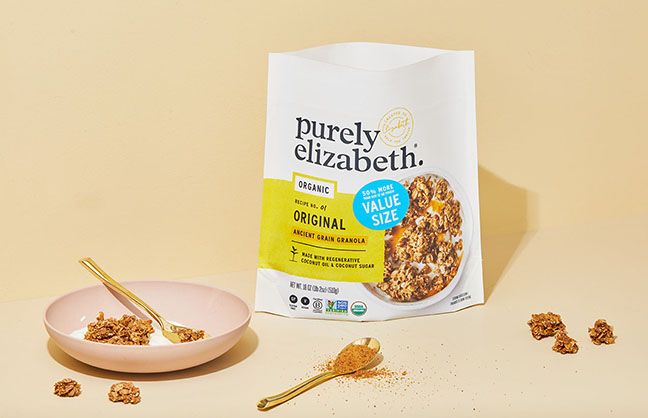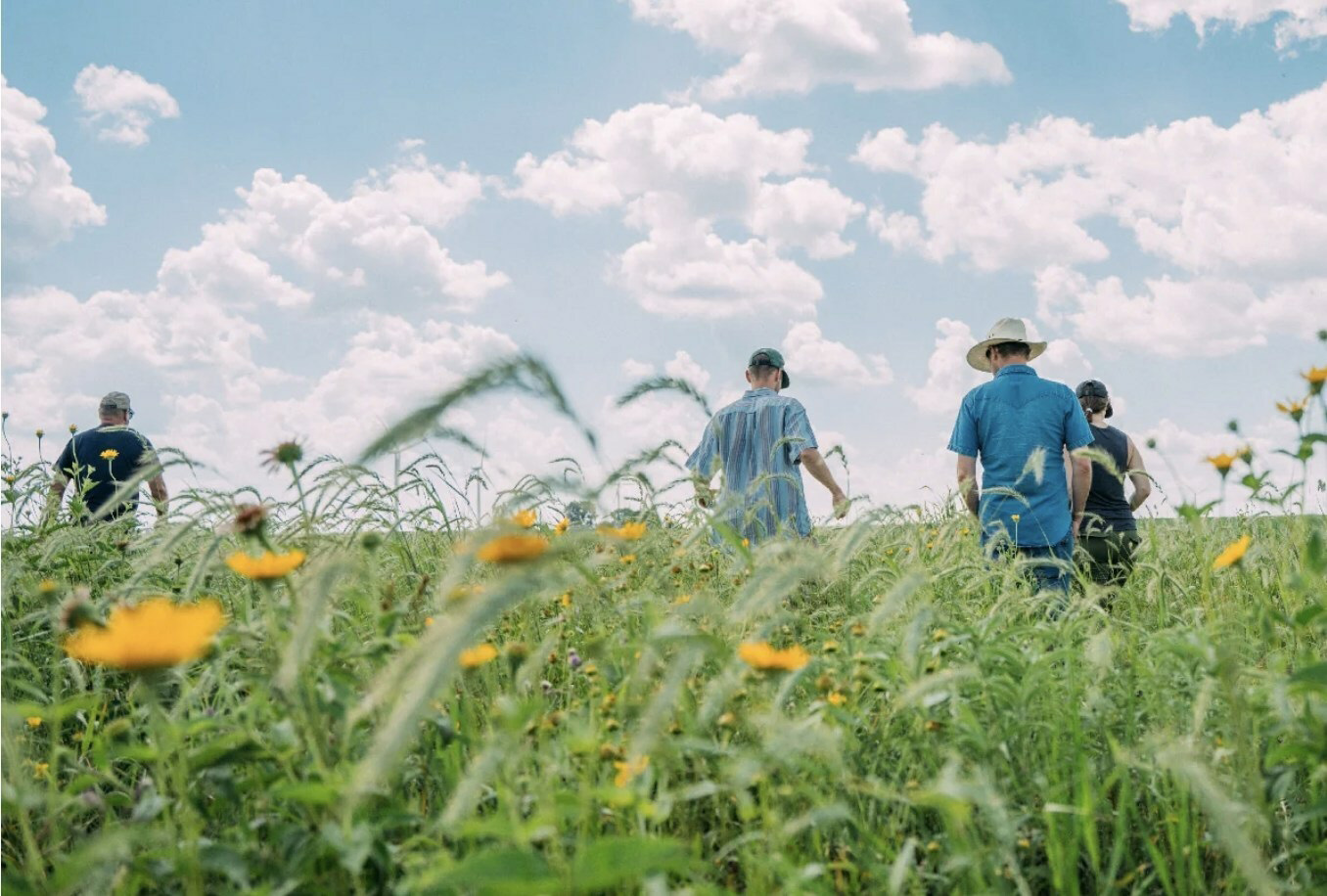Two Elizabeths have combined efforts and significant track records to tackle the food system crisis through widespread, data-driven implementation of regenerative agriculture.
“The scale of food production is enormous, but I believe it is also our greatest opportunity to make a positive impact,” said Elizabeth Stein, CEO and founder of Purely Elizabeth natural breakfast foods. The company will partner with Mad Agriculture to launch a three-year pilot project, the first Regenerative Impact Program—focused on converting farmers to regenerative practices, sourcing a strong supply of regenerative oats, and sponsoring scientific research to confirm regenerative agriculture’s impact on soil health, water conservation, biodiversity, and nutrient density.
“The Purely Elizabeth and Mad Agriculture partnership will showcase what regeneration actually looks like on a farm,” said Elizabeth Candelario, director of strategic partnerships at Mad Ag. “It is not just soil carbon…not just biodiversity. It is a full system approach that views the entire farm operation as an ecosystem.”
Boulder-based Purely Elizabeth manufactures granola, oatmeal, and cereal products. Its new value size certified organic Original Ancient Grain Granola is made with Regenerative Organic Certified coconut sugar and coconut oil.

Purely Elizabeth Ancient Grain Granola is made with Regenerative Organic Certified coconut sugar and coconut oil.
For Stein, a holistic nutrition counselor, the work will “connect the dots between nutrition and regenerative ag,” between soil health and food health. The company is working to source 5% of its oats from Montana and Idaho farmers—with a goal of raising that to 25% from regenerative organic farms.
Ecologist Philip Taylor, founder and executive director of Mad Ag, says the goal is to create direct sight lines from the brand to the farm. “The Regenerative Impact Program lifts the hood several levels deeper than a mere transaction of ingredients—it’s about relationships, where buyers get unparalleled insight into the farm, and farmers can know their food is being appreciated for how it’s grown. We see this becoming a model for many brands—any revolution depends on community and strong relationships.”
“We’re sponsoring the research…to determine the impact of regenerative particularly on nutrients,” said Christin Powers, senior manager for sourcing and sustainability at Purely Elizabeth. “Mad Ag perfectly epitomizes our approach, doing due diligence to be transparent with our customers. We hope to share the results across the industry, to strengthen our collective influence.”
“Through storytelling, we want to invite our customers on our regenerative journey,” Stein said.
Mad Agriculture: Four separate arms to help farmers and brands
The “Mad” in Mad Agriculture derives from the Mad Farmer poems of Wendell Berry, poet and environmental activist who was prepared to “go in at exits and come out at entrances,” if that’s what it takes to restore balance to a broken social, economic, and food system.
Elizabeth Candelario has been working at the nexus of climate, food, and agriculture for 15 years—11 of them at Demeter USA, certifier of biodynamic farms and products. In 2021 she started with Mad Ag and is thrilled with the comprehensive vision of its founder, Philip Taylor. “This company is about revolutionary systems change. It has the four branches under one roof, to handle all the challenges.”
Candelario sees four major challenges for farmers in transitioning: 1) agronomic know-how (the practices); 2) access to capital; 3) access to markets; and 4) support from education and media to tell the story.
Mad Capital offers financing for farmers at all stages, with adaptive loan terms; Mad Lands provides farmer-first, place-based land and business planning; Mad Markets makes the critical connection between farmers and brands who need their product; and Mad Revolution is the creative media and cultural outreach arm.
“Mad Ag is like a Swiss army knife to help farmers with every aspect of transitioning to regenerative—whether the farm is 200 or 20,000 acres,” Candelario said. “Brands need help too…they need sources of high-quality regenerative organic foods, and strong scientific data. Farmers always carry the risk; when food companies meet the farmers, they usually buy in for longer contracts. Supply chains have gotten so long—and this connection emphasizes the personal investment both parties have made.”
The vision of Mad Ag centers on “letting nature set the goal”: listening to what the land needs us to do to maintain the continual regeneration of the earth as Indigenous wisdom and practices outlined. “What regenerative ag means must flow from the farm to the C-Suite—not the other way around,” said Candelario. Mad Ag’s goal is to facilitate conversion of five million acres to regenerative organic by 2030.
The value of research
“Purely Elizabeth is activating our research arm to compare conventionally grown oats with regenerative organic oats,” Candelario said. “We’ll ask: ‘How does regenerative ag impact soil carbon compared to conventional? How does the soil carbon accumulate in each? Are the micronutrients and microbiota pointing to healthy soil? What about diversity, and nutrient density—levels of antioxidants, protein, minerals?’ The answers will give companies a fuller picture to share with consumers—while strengthening the regenerative organic brand.”
Although Mad Ag hopes that farmers will go organic and eliminate synthetic chemicals, Candelario says there is no legal definition for regenerative ag at the moment. “The Regenerative Organic Alliance set the standard, and the ROC certification requires organic as a baseline…but some farmers may not want to go organic. Every farm has a unique situation. Basically, the standards should help farmers to grow better food and regenerate the land. Farming is a journey, not a destination.”
Why has regenerative ag become a hot topic recently? “Agriculture has been the elephant in the climate living room,” said Candelario. “But this has really changed over the past few years. Climate change-fueled disasters have accelerated dramatically in recent years, touching everyone’s lives and inciting companies and politicians to take action. Additionally, recent SEC rulings indicate that publicly traded companies and companies seeking financing will be required to make climate impact disclosures, which for food companies will include their supply chain. Typically, a food company’s supply chain represents up to 70% of its total emissions, largely the result of the agricultural practices that produce their ingredients.”
Revolution back to the roots
“As we do to the Earth, we do to ourselves” epitomizes the understanding driving the Mad Revolution. Regenerative agriculture starts with regenerative soil.
“How can we heal the land?” has been Stein’s focus all along.
“As any great farmer will tell you…their first priority is to farm soil, not to farm plants,” noted Candelario.





